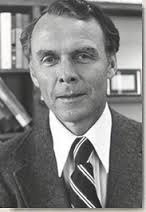Difference between revisions of "Allan Cox"
(Created page with "Allan Cox ==Country== United States ==Birth - Death== 1926 - 1987 ==Occupation== Science, Academic ==Description== Geologist and...") |
|||
| (One intermediate revision by the same user not shown) | |||
| Line 15: | Line 15: | ||
==Description== | ==Description== | ||
| − | Geologist and geophysicist, who studied plate tectonics and their role in earthquakes. Professor at Stanford University and Dean of the School of Earth Sciences. | + | Geologist and geophysicist, who studied plate tectonics and their role in earthquakes. Professor at Stanford University and Dean of the School of Earth Sciences. He was instrumental in developing a way to measure the changes in the Earth’s magnetic alignment and the geomagnetic polarity time scale. This enabled the testing of the seafloor spreading hypothesis, which gave some of the first credible evidence to the theory of plate tectonics, for which he became a leader in researching and teaching. Recipient of numerous awards, including Vetlesen Prize (1970) and the Arthur Day Prize of the National Academy of Sciences (1984). President of the American Geophysical Union from (1978-1980). Elected to the United States National Academy of Sciences, the American Academy of Arts and Sciences, and the American Philosophical Society. A number of memorial prizes were established in his name after his death. Partner was fellow geophysicist [[Clyde Wahrhaftig]]. |
| + | |||
| + | ==See Also== | ||
| + | |||
| + | * [[LGBTQ Inventors]] | ||
==Further Reading/Research== | ==Further Reading/Research== | ||
Latest revision as of 00:14, 18 June 2021
Country
United States
Birth - Death
1926 - 1987
Occupation
Science, Academic
Description
Geologist and geophysicist, who studied plate tectonics and their role in earthquakes. Professor at Stanford University and Dean of the School of Earth Sciences. He was instrumental in developing a way to measure the changes in the Earth’s magnetic alignment and the geomagnetic polarity time scale. This enabled the testing of the seafloor spreading hypothesis, which gave some of the first credible evidence to the theory of plate tectonics, for which he became a leader in researching and teaching. Recipient of numerous awards, including Vetlesen Prize (1970) and the Arthur Day Prize of the National Academy of Sciences (1984). President of the American Geophysical Union from (1978-1980). Elected to the United States National Academy of Sciences, the American Academy of Arts and Sciences, and the American Philosophical Society. A number of memorial prizes were established in his name after his death. Partner was fellow geophysicist Clyde Wahrhaftig.

